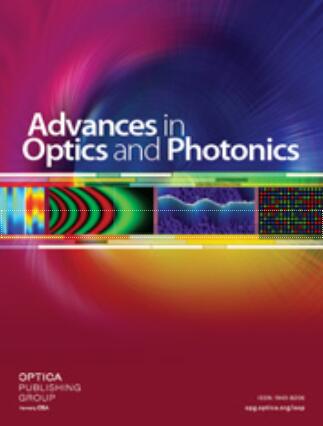超快二阶非线性光子学--从经典物理学到非高斯量子动力学
IF 25.2
1区 物理与天体物理
Q1 OPTICS
引用次数: 1
摘要
具有二阶($\chi^{(2)}$)非线性的光子集成电路正在迅速扩展到极低的功率。目前,最先进的设备在连续波激光器的驱动下可实现数千个光子的饱和非线性相互作用,而使用超快脉冲可进一步降低这些能量要求,这可能会很快将非线性光学推向单光子非线性领域。本教程回顾了超快非线性光子学的这些最新发展,讨论了实现少光子非线性相互作用的设计策略,并使用从经典行为平滑插值到少光子尺度的框架,对超快量子非线性光学进行了统一处理。由于存在大量耦合光学模式,这些新兴的量子光学平台与腔体量子电动力学的典型实现有着本质区别。经典的多模行为在非线性光学中得到了很好的研究,著名的例子包括孤子形成和超连续产生。相比之下,多模量子系统表现出的行为种类要多得多,但闭式求解却比经典的量子系统更加稀少。在开发超快量子光学框架的过程中,我们将确定哪些行为可以从经典器件延续到量子器件,哪些直觉必须放弃,以及超快和量子非线性光学的交叉点存在哪些新机遇。虽然本文的重点是在具有 $\chi^{(2)}$ 非线性的器件的经典行为和量子行为之间建立联系,但本文所开发的框架是通用的,很容易扩展到对基于三阶($\chi^{(3)}$)非线性的动态过程的描述。本文章由计算机程序翻译,如有差异,请以英文原文为准。
Ultrafast second-order nonlinear photonics—from classical physics to non-Gaussian quantum dynamics
Photonic integrated circuits with second-order ($\chi^{(2)}$) nonlinearities are rapidly scaling to remarkably low powers. At this time, state-of-the-art devices achieve saturated nonlinear interactions with thousands of photons when driven by continuous-wave lasers, and further reductions in these energy requirements enabled by the use of ultrafast pulses may soon push nonlinear optics into the realm of single-photon nonlinearities. This tutorial reviews these recent developments in ultrafast nonlinear photonics, discusses design strategies for realizing few-photon nonlinear interactions, and presents a unified treatment of ultrafast quantum nonlinear optics using a framework that smoothly interpolates from classical behaviors to the few-photon scale. These emerging platforms for quantum optics fundamentally differ from typical realizations in cavity quantum electrodynamics due to the large number of coupled optical modes. Classically, multimode behaviors have been well studied in nonlinear optics, with famous examples including soliton formation and supercontinuum generation. In contrast, multimode quantum systems exhibit a far greater variety of behaviors, and yet closed-form solutions are even sparser than their classical counterparts. In developing a framework for ultrafast quantum optics, we will identify what behaviors carry over from classical to quantum devices, what intuition must be abandoned, and what new opportunities exist at the intersection of ultrafast and quantum nonlinear optics. While this article focuses on establishing connections between the classical and quantum behaviors of devices with $\chi^{(2)}$ nonlinearities, the frameworks developed here are general and are readily extended to the description of dynamical processes based on third-order ($\chi^{(3)}$) nonlinearities.
求助全文
通过发布文献求助,成功后即可免费获取论文全文。
去求助
来源期刊

Advances in Optics and Photonics
OPTICS-
CiteScore
56.60
自引率
0.00%
发文量
13
期刊介绍:
Advances in Optics and Photonics (AOP) is an all-electronic journal that publishes comprehensive review articles and multimedia tutorials. It is suitable for students, researchers, faculty, business professionals, and engineers interested in optics and photonics. The content of the journal covers advancements in these fields, ranging from fundamental science to engineering applications.
The journal aims to capture the most significant developments in optics and photonics. It achieves this through long review articles and comprehensive tutorials written by prominent and respected authors who are at the forefront of their fields.
The journal goes beyond traditional text-based articles by enhancing the content with multimedia elements, such as animation and video. This multimedia approach helps to enhance the understanding and visualization of complex concepts.
AOP offers dedicated article preparation and peer-review support to assist authors throughout the publication process. This support ensures that the articles meet the journal's standards and are well-received by readers.
Additionally, AOP welcomes comments on published review articles, encouraging further discussions and insights from the scientific community.
In summary, Advances in Optics and Photonics is a comprehensive journal that provides authoritative and accessible content on advancements in optics and photonics. With its diverse range of articles, multimedia enhancements, and dedicated support, AOP serves as a valuable resource for professionals and researchers in these fields.
 求助内容:
求助内容: 应助结果提醒方式:
应助结果提醒方式:


